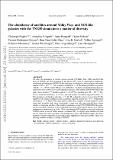| dc.contributor.author | Engler, Christoph | |
| dc.contributor.author | Pillepich, Annalisa | |
| dc.contributor.author | Pasquali, Anna | |
| dc.contributor.author | Nelson, Dylan | |
| dc.contributor.author | Rodriguez-Gomez, Vicente | |
| dc.contributor.author | Chua, Kun Ting Eddie | |
| dc.contributor.author | Grebel, Eva K | |
| dc.contributor.author | Springel, Volker | |
| dc.contributor.author | Marinacci, Federico | |
| dc.contributor.author | Weinberger, Rainer | |
| dc.contributor.author | Vogelsberger, Mark | |
| dc.contributor.author | Hernquist, Lars | |
| dc.date.accessioned | 2022-05-06T17:37:50Z | |
| dc.date.available | 2022-05-06T17:37:50Z | |
| dc.date.issued | 2021 | |
| dc.identifier.uri | https://hdl.handle.net/1721.1/142407 | |
| dc.description.abstract | We study the abundance of satellite galaxies around 198 Milky Way- (MW) and M31-like hosts in TNG50, the final installment in the IllustrisTNG suite of cosmological magnetohydrodynamical simulations. MW/M31-like analogues are defined as discy galaxies with stellar masses of $M_* = 10^{10.5 - 11.2}~\rm {M}_\odot$ in relative isolation at z = 0. By defining satellites as galaxies with $M_* \ge 5\times 10^{6}~\rm {M}_\odot$ within $300~\rm {kpc}$ (3D) of their host, we find a remarkable level of diversity and host-to-host scatter across individual host galaxies. The median TNG50 MW/M31-like galaxy hosts a total of $5^{+6}_{-3}$ satellites with $M_* \ge 8 \times 10^6~\rm {M}_\odot$, reaching up to $M_* \sim 10^{8.5^{+0.9}_{-1.1}}~\rm {M}_\odot$. Even at a fixed host halo mass of $10^{12}~\rm {M}_\odot$, the total number of satellites ranges between 0 and 11. The abundance of subhaloes with $M_\rm {dyn} \ge 5 \times 10^7~\rm {M}_\odot$ is larger by a factor of more than 10. The number of all satellites (subhaloes) ever accreted is larger by a factor of 4–5 (3–5) than those surviving to z = 0. Hosts with larger galaxy stellar mass, brighter K-band luminosity, more recent halo assembly, and – most significantly – larger total halo mass typically have a larger number of surviving satellites. The satellite abundances around TNG50 MW/M31-like galaxies are consistent with those of mass-matched hosts from observational surveys (e.g. SAGA) and previous simulations (e.g. Latte). While the observed MW satellite system falls within the TNG50 scatter across all stellar masses considered, M31 is slightly more satellite-rich than our 1σ scatter but well consistent with the high-mass end of the TNG50 sample. We find a handful of systems with both a Large and a Small Magellanic Cloud-like satellite. There is no missing satellites problem according to TNG50.</jats:p> | en_US |
| dc.language.iso | en | |
| dc.publisher | Oxford University Press (OUP) | en_US |
| dc.relation.isversionof | 10.1093/MNRAS/STAB2437 | en_US |
| dc.rights | Attribution-NonCommercial-ShareAlike 4.0 International | en_US |
| dc.rights.uri | https://creativecommons.org/licenses/by-nc-sa/4.0/ | en_US |
| dc.source | arXiv | en_US |
| dc.title | The abundance of satellites around Milky Way- and M31-like galaxies with the TNG50 simulation: a matter of diversity | en_US |
| dc.type | Article | en_US |
| dc.identifier.citation | Engler, Christoph, Pillepich, Annalisa, Pasquali, Anna, Nelson, Dylan, Rodriguez-Gomez, Vicente et al. 2021. "The abundance of satellites around Milky Way- and M31-like galaxies with the TNG50 simulation: a matter of diversity." Monthly Notices of the Royal Astronomical Society, 507 (3). | |
| dc.contributor.department | Massachusetts Institute of Technology. Department of Physics | |
| dc.contributor.department | MIT Kavli Institute for Astrophysics and Space Research | |
| dc.relation.journal | Monthly Notices of the Royal Astronomical Society | en_US |
| dc.eprint.version | Author's final manuscript | en_US |
| dc.type.uri | http://purl.org/eprint/type/JournalArticle | en_US |
| eprint.status | http://purl.org/eprint/status/PeerReviewed | en_US |
| dc.date.updated | 2022-05-06T17:28:08Z | |
| dspace.orderedauthors | Engler, C; Pillepich, A; Pasquali, A; Nelson, D; Rodriguez-Gomez, V; Chua, KTE; Grebel, EK; Springel, V; Marinacci, F; Weinberger, R; Vogelsberger, M; Hernquist, L | en_US |
| dspace.date.submission | 2022-05-06T17:28:14Z | |
| mit.journal.volume | 507 | en_US |
| mit.journal.issue | 3 | en_US |
| mit.license | OPEN_ACCESS_POLICY | |
| mit.metadata.status | Authority Work and Publication Information Needed | en_US |
